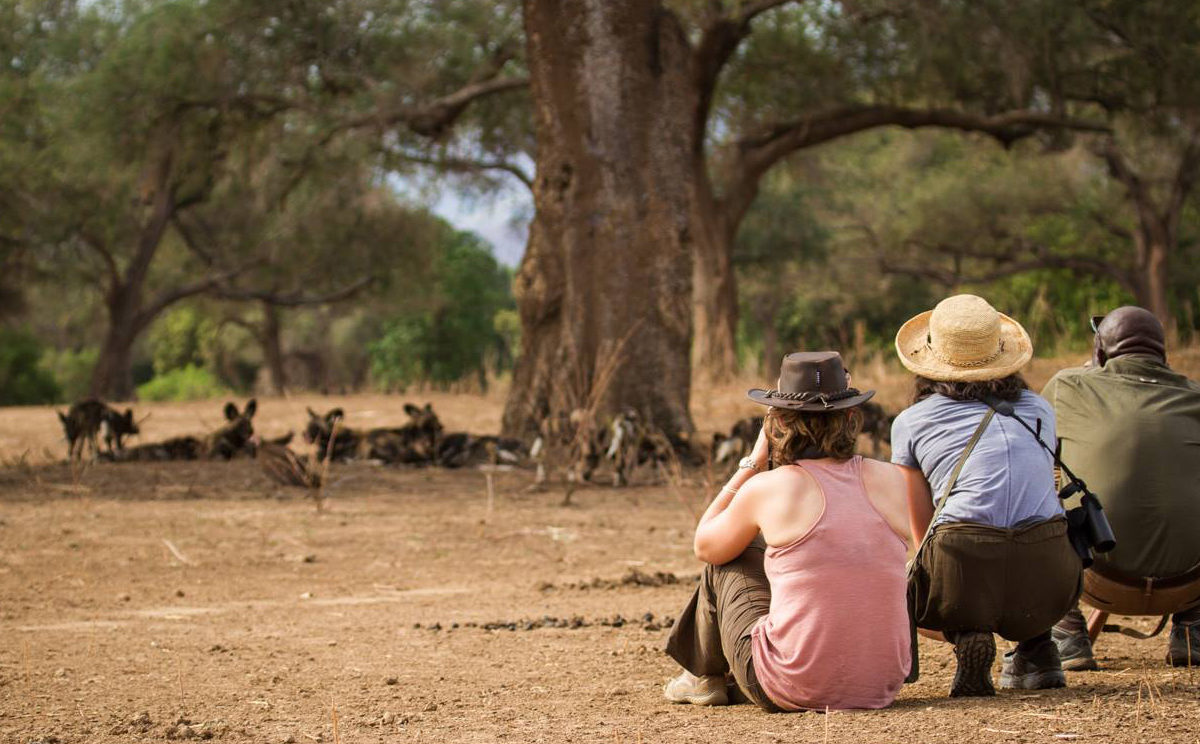African wild dogs are one of the continent’s most captivating carnivores and one of its most endangered species.

We sat silently, watching the wild dogs. Sixteen in total. They lay napping in a shady depression, camouflaged by their mottled coats.
The air was warm and still. The only sound to be heard was distant birds. Aside from the occasional flick of a tail, the pack lay inert. The sun sank lower in the sky.
One by one the dogs woke, yawned and stretched. Getting to their feet, the pack members exchanged elaborate greetings, whimpering as they sniffed, smelt and licked one another.
The dogs became livelier, and it became apparent what the 20 or 30 hooded vultures lurking in the wings had been waiting for. In preparation for their evening hunt, the dogs vacated their digestive systems. I watched, horrified, as the vultures squabbled over and made quick work of these deposits.
Having lightened their load, the dogs pranced and played, making half-hearted, playful attempts to catch the still-lurking vultures. There was a definite light-hearted atmosphere among the pack members as they gambolled together, waiting for the last few deep sleepers to stir.

Watching wild dogs. Picture: Shaun Stanley
Playtime over, it was time to get to work, and the pack readied for the night’s hunt.
A hyena appeared, previously hidden from sight, obviously intending to follow the dogs in the hope of scoring a free meal.
We had come to Mana Pools to stay at African Bush Camps and we were fortunate to see wild dogs from two of their camps.
Zambezi Expeditions camp is perched on the banks of the Zambezi, with the magnificent backdrop of Zambia and the Zambezi Escarpment across the river. Nyamatusi Camp is their stunning, brand new camp where we relaxed in the lap of luxury in between game drives and wild dog sightings.
It was on an afternoon drive from Zambezi Expeditions that we’d had our first wild dog encounter and when we moved camp to Nyamatusi we would see the dogs again the next morning. After what had clearly been a successful hunt, they lay resting, with blood-smeared faces and bloated tummies.
A jumping wild dog. Picture: Shaun Stanley
The Zambezi River at Mana Pools is wide and dotted with islands. The silhouettes of elephant, buffalo and hippo are visible as they wade in the shallows and feed on the banks.
Mana Pools is a 219,600ha wildlife conservation area, national park and World Heritage area in northern Zimbabwe, situated along the lower stretches of the Zambezi River.
Over time, the river has gradually changed its course, leaving behind river channels, ox-bow lakes and seasonal pools, surrounded by forests of winter thorn, mahogany, wild fig, ebony and baobab trees.
Mana is the Shona word for four, and within the park the abandoned river channels have created four large pools, giving the park its name. All this water provides abundant vegetation, attracting a wealth of wildlife.
Elephants feed on a tree by the Zambezi River. Picture: iStock
In the dry season, the shady glades beneath the trees are filled with herds of impala, eland, elephant, zebra, buffalo, waterbuck and kudu. These populations provide a plentiful supply of prey for both predators and scavengers. There are several sizeable lion prides, as well as leopard and hyena.
Mana Pools is a stronghold for the wild dog. Currently listed as endangered by the International Union for Conservation of Nature, with only 6,600 remaining in the wild, African wild dogs are one of the continent’s most captivating carnivores and one of its most endangered species. Once found all over Africa, their numbers have drastically declined over the last 100 years.
Seen as pests by farmers and blamed for livestock deaths they are often poisoned, and can catch distemper and rabies from domestic dogs. With vast home ranges, wild dogs are vulnerable to humans. Nowadays populations are limited to pockets of wildlife sanctuaries and reserves.
At Mana Pools wild dogs live far from human habitation, so the risk to their survival is limited. They thrive in the park and can be seen hunting twice a day, in the early morning and late afternoon.
Wild dogs at Mana Pools. Picture: Shaun Stanley
There are six main wild dog packs in the park, numbering around 100. Three of these packs live on the flood plains and have become accustomed to human visitors.
Wild dogs are successful hunters, having a success rate of around 80%, which is remarkable considering lions average around 30%. Hunting in packs that number anywhere from five to 40, the adults combine to become an awesome killing machine, communicating constantly with birdlike chirrups and hoots.
They are prodigious athletes, able to outrun almost any creature over long distances. Using stamina to overcome their prey, they can maintain an impressive 50km/h for extended periods, occasionally reaching top speeds of 70km/h, basically running their prey to exhaustion.
Wild dogs’ ability to coordinate their moves, combined with their relentless running skills, enables them to take down an animal over 10 times their size and literally tear it limb from limb at an astonishing rate, eating almost the entire carcass.
Wild dog puppies play fighting at Mana Pools. Picture: iStock
Wild dog packs have an extraordinary social dynamic. They play, nurture and communicate with one another, functioning as a highly integrated group. Play forms an important part of their society and helps to reinforce pack hierarchies and bonds.
Each pack member takes on a different role within the group. With their intriguing markings, each as unique as a fingerprint, and an intimate social structure combined with impressive hunting success, they are fascinating to watch.
After the hunt, the pack returns to the den, where they regurgitate the kill for pups as well as old or injured pack members.
Wild dogs are a weathervane species for conservation, an indicator of the health of the whole ecosystem. Their presence at Mana Pools is a sign of a balanced environment.
For more information visit www.africanbushcamps.com
This article appeared first on Safari News
For more news your way, download The Citizen’s app for iOS and Android.






